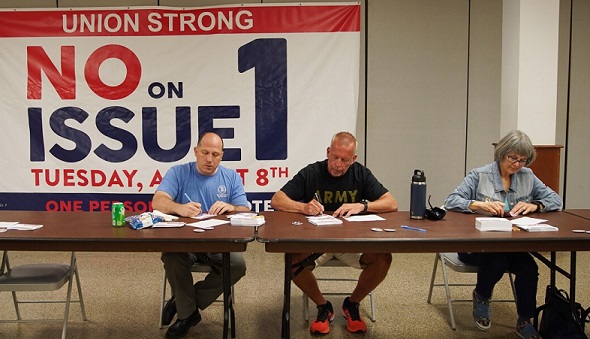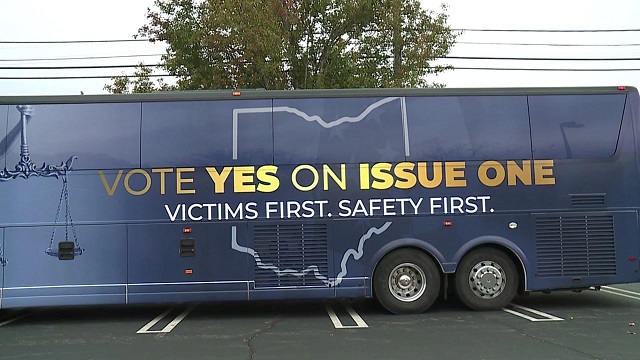Everything You Need To Know About The August Vote On Issue 1!
FEATURED PHOTO: (L-R) LT. GOVERNOR JON HUSTED, GOVERNOR DEWINE AND SECRETARY OF STATE FRANK LAROSE HAVE ALL STATED ISSUE 1 MUST PASS TO STOP AN ABORTIONS AMENDMENT

SignalCleveland.org, By Frank W. Lewis, Posted July 18th 2023
This ballot measure would have a profound impact on Ohio politics.
On Aug. 8, Ohio voters will have the opportunity to vote in a rare statewide summer election on a matter with far-reaching consequences. Issue 1 is a ballot initiative that, if passed, would make it harder for citizens to change the state constitution.
The most significant change would be requiring that a ballot initiative win 60% of the vote to pass. Since 1912, the requirement has been a simple majority, 50% plus one vote.
What is a ballot initiative?
In Ohio, citizens can attempt to amend the state constitution, create a new law, or repeal all or part of an existing law through a ballot initiative. The Ohio Secretary of State’s website explains the differences. Issue 1 would apply only to attempts to amend the state constitution.
The entire process is detailed and time-consuming. Briefly: the citizens leading the effort must submit proposed language to the Ohio Ballot Board for approval, then use that description of the initiative on the petitions they circulate.

Current law requires signatures from at least 44 counties. Issue 1 would increase that to all 88 counties.
State legislators can also propose a constitutional amendment, and that’s how Issue 1 came about. Republicans, who hold large majorities in the Ohio House of Representatives and Senate, approved a resolution in May that put Issue 1 on the ballot in August. (In the Senate, every Republican voted in favor and every Democrat voted against. In the House, five Republicans joined all Democrats in opposing the resolution.)
If Issue 1 passes, an amendment proposed by legislators would also need 60% of the vote.
Why is this vote in August?
In March, Ohio Sen. Matt Huffman, a Republican, told reporters that it’s important to get Issue 1 on the ballot in August to make it harder to pass other ballot initiatives that are expected later this year: one to ensure the right to reproductive decisions, including abortion, and another legalizing the cultivation, sale and purchase of marijuana for recreational purposes.
In May, Ohio Secretary of State Frank LaRose told the crowd at a Seneca County Republican Party event that Issue 1 is “100% about keeping a radical pro-abortion amendment out of our constitution. The left wants to jam it in there this coming November.”
That contradicts what LaRose has said when reporters have asked about the timing. Like most other Republicans, he has repeatedly denied that Issue 1 is an attempt to prevent abortion rights in Ohio.
Late last year, Republicans passed a bill that, among other things, eliminated almost all August special elections. State Rep. Thomas Hall, who introduced that bill in 2021, said this was to “save taxpayer dollars.” LaRose added in a statement: “August special elections impose an unnecessary financial and administrative burden on our 88 county boards of elections, and because of the historically low voter turnout in August elections, they produce skewed election results that often do not reflect the will of the people.”
But then in 2022, voters in five states where amendments affecting abortion rights were on the ballot clearly chose access over restrictions. In four of those states, the proposed amendments received between 52% and 59% of the vote.

A poll conducted in Ohio last October found that 59.1% of voters supported amending the state constitution to keep abortion legal in the state.
Who supports Issue 1?
Two Republican legislators wrote the official statement in favor of Issue 1 posted on the Secretary of State’s website. They wrote: “A YES vote on Issue 1 protects our Constitution from deep-pocketed, out-of-state interests. By passing Issue 1, the People will ensure constitutional changes are widely accepted and declare that Ohio’s Constitution is not for sale.”
The anti-abortion group Ohio Right to Life contends (falsely) that without Issue 1, abortion-rights supporters will attempt to legalize abortion “up until birth with zero restrictions.” (The proposed Ohio Right to Make Reproductive Decisions Including Abortion Initiative states that “abortion may be prohibited after fetal viability.”)
The Ohio Farm Bureau supports Issue 1 because it will make it harder for “outside special interest groups to push anti-agricultural initiatives.” The Buckeye Firearms Association makes a similar argument: “It’s about protecting our rights and shielding our state constitution from big money meddlers so that we’re not subject to the fickle political whims of the moment.”

The Ohio Chamber of Commerce backs Issue 1 but has taken no position on abortion. Chamber CEO Steve Stivers said in April that the business group opposes another ballot initiative anticipated in 2024 that would gradually raise the minimum wage to $15 per hour.
Who opposes Issue 1?
Five Democratic legislators submitted the party’s official statement against Issue 1 to the Secretary of State’s website. They wrote: “It takes away our freedom by undermining the sacred principle of ‘one person, one vote’ and destroys majority rule in Ohio.”
One Person One Vote is also the name of a coalition of around 200 organizations that oppose Issue 1.
Cleveland Mayor Justin Bibb, Cleveland City Council and the bipartisan Ohio Alliance of Mayors have issued statements urging voters to oppose Issue 1. Four former Ohio governors — two Republicans and two Democrats — have also spoken out against it.
How would this change affect politics in Ohio?
In April, former Gov. Robert Taft, a Republican, wrote an open letter urging legislators not to pass the resolution that put Issue 1 on the ballot in August. He pointed out that if the 60% threshold had been in effect when he was in office, “two signature initiatives, the Clean Ohio Fund and the Third Frontier Project, would not have been approved. … Both measures have stood the test of time, contributing importantly to the economy and quality of life of our state.”
Cleveland.com reporter Andrew Tobias reviewed the history of proposed constitutional amendments in Ohio to determine which ones that passed would have fallen short of 60% of the vote. They include: raising the minimum wage and indexing it to inflation (2006, 57% of the vote); and legalizing casino gambling in four cities (2009, 53%).
The Cleveland casino has generated more than $17 million in tax revenue that City Council members have spent on ward projects.








